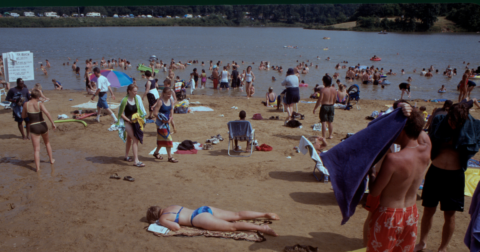Explainer
Your Thanksgiving Meal’s Climate Impact, in 4 Charts
Climate•4 min read
News
The summer of 2025 was the most un-swimmable Iowa summer yet, thanks in part to pollution from farms.


Words by Nina B. Elkadi
In many parts of Iowa, getting in the lake on a hot summer day is a bygone memory. The summer of 2025 had the highest number of state beach advisories since the Iowa Environmental Council, a non-profit environmental group, began tracking beach advisory data in 2014. Of the 41 public beaches monitored, the Iowa Department of Natural Resources issued 158 beach advisories for E. coli, a bacteria found in the lower intestines of mammals, and 13 for microcystin, a toxin produced by algae — both pathogens can cause gastroenteritis and liver damage.
Iowa Governor Kim Reynolds has said that “regulation is hardly ever the answer” to the state’s water quality woes. Yet Iowa has become known for its polluted waterways, and the state is saturated with industrial agriculture operations — all of which produce manure, synthetic fertilizer and pesticides that end up in soils and waterways. Agricultural pollutants in Iowa water have led public water utilities to hike rates and enact lawn watering bans. Reynolds’ office did not respond to Sentient’s request for comment.
These beach advisories paint another consequence of the water crisis, which is that in an increasingly warming climate, lakes are no longer places where residents can swim or recreate. At the 40 lakes where water is tested, the Iowa Department of Natural Resources will post a sign if there is an advisory. But the ever-changing levels of pollution mean that someone could go for a swim right before an advisory is posted and get sick.
“We know that people are getting sick,” Sarah Howe, Water and Climate Resiliency Specialist at the Iowa Environmental Council tells Sentient, “whether it’s because those advisories are ill-timed, or there’s a lack of translation services or people are simply choosing to recreate regardless.”
One way to reduce E. coli in lakes in Iowa would be to reduce how much fertilizer, manure and other agricultural runoff goes from farms into the water, Chris Jones, water quality expert and author of The Swine Republic, wrote to Sentient.
Iowa is the leading pork producer in the U.S., and also holds the number one seat for egg production. This scale of production relies on industrial operations, which can house thousands of animals in concentrated animal feeding operations. In Iowa, factory farms dot the landscape, housing around 124 million farm animals in confined operations, producing 100 billion pounds of manure. Manure is typically stored in wastewater lagoons until it can be applied to crop fields as fertilizer during the planting period — a limited timeframe that constrains transport and application across all crop fields. Illegal manure spills, too, are the new normal. A big rain event can cause that manure to run off the fields and enter nearby bodies of water. Some cattle also have direct access to streams, and their manure will also flow into rivers and lakes, adding to the pollution.
Outdated septic systems, which can sometimes be faulty, should also be updated to avoid leaks, Jones says.
Jones is the president of Driftless Water Defenders, a non-profit advocacy group focused on water quality. This summer, Driftless Water Defenders, along with Progress Iowa, Iowa Citizens for Community Improvement and Food & Water Watch, all non-profit groups advocating for clean water, hosted the 48 Lake Initiative, a project to inform Iowa residents about what Iowa lakes used to be like — and how new memories are now clouded by the pollution that has rendered many of them un-swimmable.
One way to address water pollution is with technology that cleans the water, which is what the city of Des Moines does with its state-of-the-art nitrate-removal facility.
Another is through attempting to restore waterways, like Lake Darling, which received a $12 million restoration by the Iowa Department of Natural Resources in 2014. Yet this year this lake had the “worst beach health,” Howe says, with ten E. coli advisories and six microcystin advisories. “It is clear that something is needed beyond these interventions.” Industrial-scale animal agriculture operations are hotspots for pathogens, including those that can be resistant to antibiotics, Howe explains.
The Iowa chapter of Food & Water Watch, a group that calls for stricter regulations on factory farming, was an advocate for the Clean Water for Iowa Act that failed to advance in the 2025 state legislative session. The bill aimed to treat factory farms like any other industrial facility rather than exempt them from National Pollution Discharge Elimination System permitting requirements, which would require them to monitor and report discharges. “It is abundantly clear that Iowa’s reliance on voluntary water clean-up strategies is failing,” Mankel wrote to Sentient.
As the climate continues to change, the water situation in Iowa may only get worse, Mankel also wrote, adding, “A changing climate with more storms, drought and flash flooding will only exacerbate the status quo.”